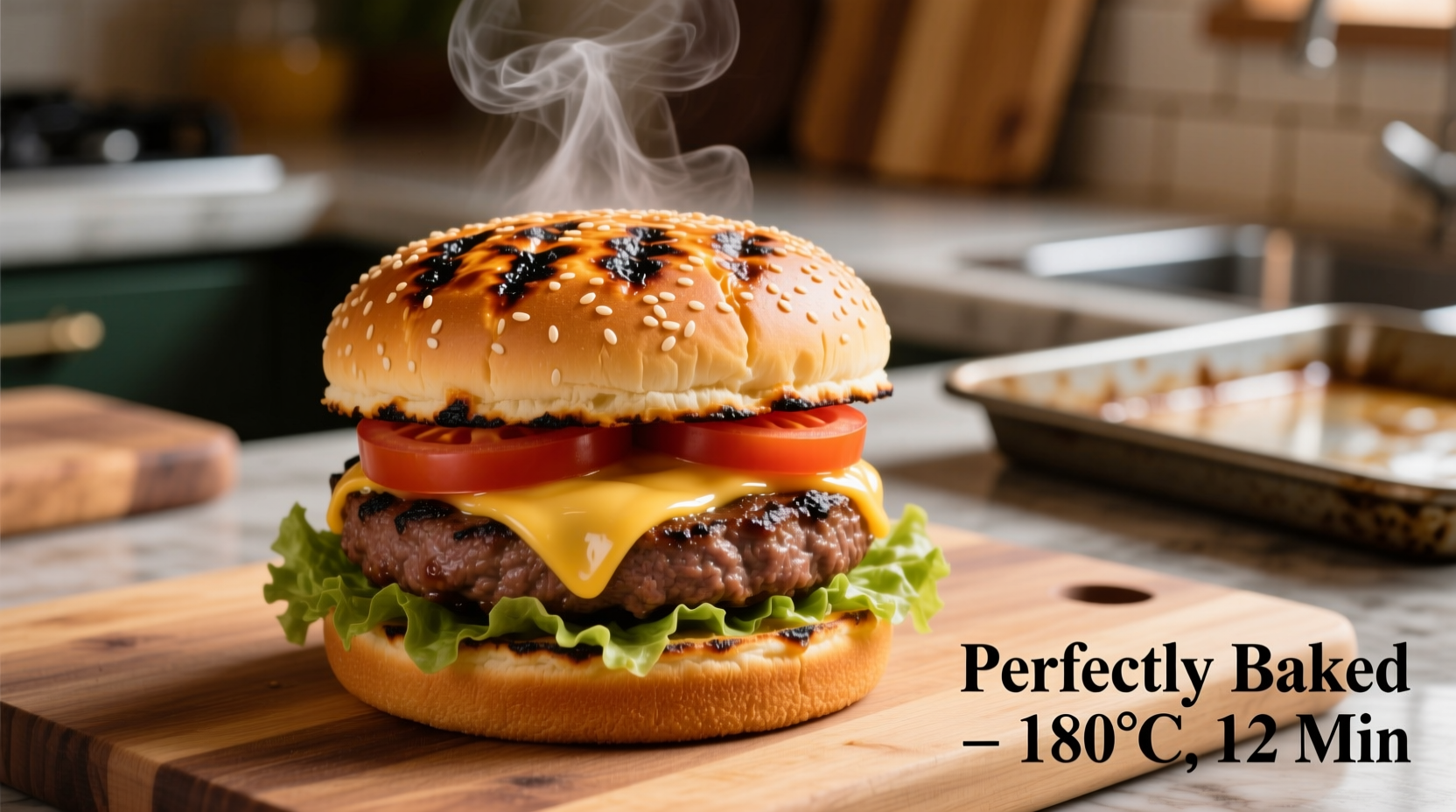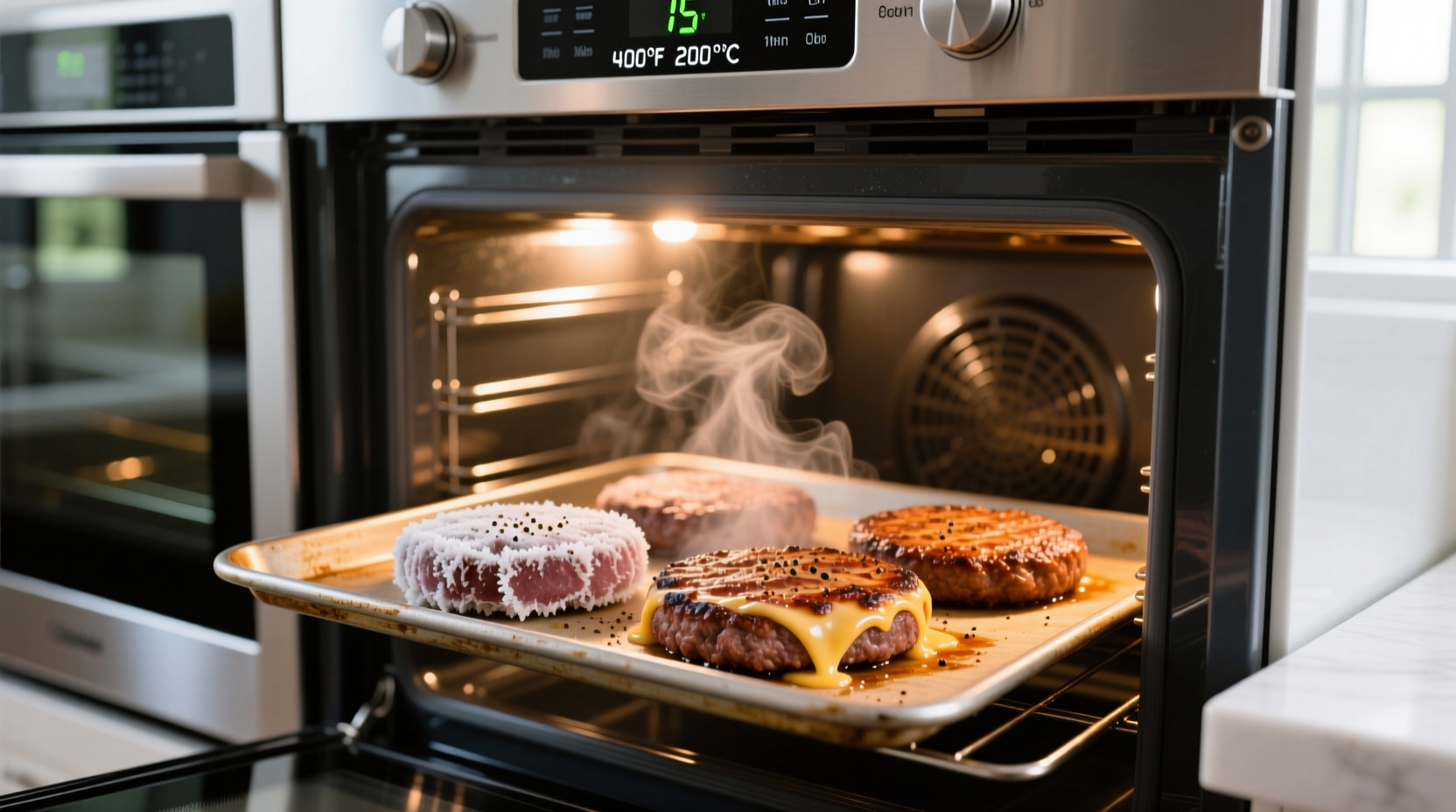Direct Answer: Cook frozen burgers in a preheated 400°F (204°C) oven for 25-35 minutes, flipping halfway, until they reach a safe internal temperature of 160°F (71°C). Thicker patties may require up to 40 minutes.
Nothing beats the convenience of cooking frozen burgers straight from the freezer—but getting them perfectly cooked without drying them out requires precise timing and technique. This guide delivers science-backed cooking times, temperature guidelines, and professional chef tips to transform frozen patties into juicy, flavorful burgers every time. Skip the guesswork and achieve restaurant-quality results with this comprehensive oven cooking method.
Why Oven Cooking Beats Thawing for Frozen Burgers
Contrary to popular belief, cooking frozen burgers directly yields better results than thawing first. The USDA Food Safety and Inspection Service confirms that cooking frozen ground beef is safe when proper internal temperatures are reached. The slow, even heat of an oven prevents the exterior from overcooking while the interior thaws—a common problem with pan-frying frozen patties.
| Burger Thickness | Oven Temperature | Total Cooking Time | Flipping Point |
|---|---|---|---|
| 1/3 inch (standard) | 400°F (204°C) | 25-30 minutes | 12-15 minutes |
| 1/2 inch (thick) | 400°F (204°C) | 30-35 minutes | 15-18 minutes |
| 3/4 inch (gourmet) | 375°F (190°C) | 35-40 minutes | 18-20 minutes |
Source: USDA Food Safety and Inspection Service temperature guidelines for ground beef
Step-by-Step Oven Cooking Process
Preparation: 5 Minutes
Preheat your oven to 400°F (204°C) with the rack positioned in the center. Line a baking sheet with aluminum foil for easy cleanup, then place an oven-safe wire rack on top. Lightly spray the rack with cooking oil to prevent sticking. Arrange frozen burgers on the rack with at least 1 inch between patties for proper air circulation.
Cooking: 25-40 Minutes

Cook for 12-15 minutes (for standard thickness), then carefully flip using a thin spatula. Continue cooking for another 13-25 minutes depending on thickness. Convection ovens reduce cooking time by 10-15%—adjust accordingly. Never cover burgers during cooking, as this traps steam and prevents proper browning.
Doneness Verification: Non-Negotiable Safety Check
The only reliable method to confirm doneness is using a digital meat thermometer. Insert horizontally into the thickest part of the burger. The USDA mandates 160°F (71°C) for ground beef to eliminate harmful bacteria like E. coli. Visual cues alone (color, juices) are unreliable indicators for frozen-to-cooked transitions.
Context-Specific Adjustments You Must Know
Your oven's actual temperature may vary by 25°F from the setting—use an oven thermometer for accuracy. Gas ovens typically require 25°F higher temperature than electric models due to moisture content in combustion. If using a convection setting, reduce temperature by 25°F and check 5 minutes early. Never cook frozen burgers below 375°F, as this creates a dangerous temperature zone where bacteria multiply rapidly during extended thawing periods.
Troubleshooting Common Frozen Burger Issues
Dry, Crumbly Burgers
Overcooking is the primary culprit. Frozen burgers contain ice crystals that turn to steam during cooking. Exceeding recommended times evaporates this moisture, resulting in dry patties. Solution: Remove burgers at 155°F—they'll carryover cook to 160°F during 3-minute resting.
Uneven Cooking
Thicker edges cooking faster than centers indicates improper rack placement. Solution: Position burgers on the center rack with adequate spacing. For convection ovens, rotate the baking sheet 180 degrees when flipping.
Excessive Smoke
Fat dripping onto oven elements causes smoking. Solution: Place a shallow pan of water on the bottom rack to catch drippings and create steam that reduces flare-ups.
Maximizing Flavor Without Thawing
Season frozen burgers immediately before cooking—salt draws out moisture when applied too early. Create a flavor boost by mixing 1 tsp Worcestershire sauce with ½ tsp onion powder and rubbing gently onto the surface after flipping. For cheeseburgers, add cheese during the last 3 minutes of cooking to allow proper melting without burning.
Professional Chef's Timing Insight
"The critical window for frozen burgers is the flip point," explains Antonio Rodriguez, culinary expert with Michelin-starred kitchen experience. "When you see dark brown crust forming on the bottom with minimal sticking, that's your signal. Wait too long and the burger fuses to the rack; flip too soon and you lose precious sear development. Master this timing and you'll consistently achieve juicy results."
Frequently Asked Questions
Can I cook frozen burgers at 350°F instead of 400°F?
While possible, 350°F extends cooking time to 35-45 minutes, increasing the risk of dry burgers. The USDA recommends cooking ground beef through the danger zone (40-140°F) as quickly as possible for safety. Higher temperatures create better crust development while minimizing moisture loss during the critical thawing phase.
Do I need to flip frozen burgers when oven cooking?
Yes, flipping is essential for even cooking. Frozen burgers develop a crust on the bottom while the top remains partially frozen. Flipping halfway through cooking ensures both sides develop proper texture and color. Skip flipping and you'll get one overcooked side and one undercooked side.
How do I prevent frozen burgers from shrinking?
Create a slight dimple in the center of each patty before cooking. As proteins contract during heating, this counteracts the natural tendency to ball up. Avoid pressing burgers with a spatula during cooking—that squeezes out precious juices. Proper spacing on the rack (1 inch minimum) also prevents steam buildup that accelerates shrinkage.
Can I cook frozen turkey or chicken burgers using this method?
Yes, but with critical adjustments. Poultry requires 165°F internal temperature. Increase cooking time by 5-10 minutes and verify with a thermometer. The FDA advises against cooking frozen poultry in slow cookers, but oven methods are safe when proper temperatures are reached. Always use a separate thermometer for poultry to prevent cross-contamination.
Why do my oven-cooked frozen burgers stick to the rack?
Three common causes: 1) Rack not properly preheated with the oven, 2) Insufficient oil spray before adding burgers, or 3) Flipping too early before crust formation. Professional kitchens solve this by heating the rack for 5 minutes before adding oiled burgers. Wait until you see dark browning and minimal resistance when gently nudging the burger before flipping.











 浙公网安备
33010002000092号
浙公网安备
33010002000092号 浙B2-20120091-4
浙B2-20120091-4